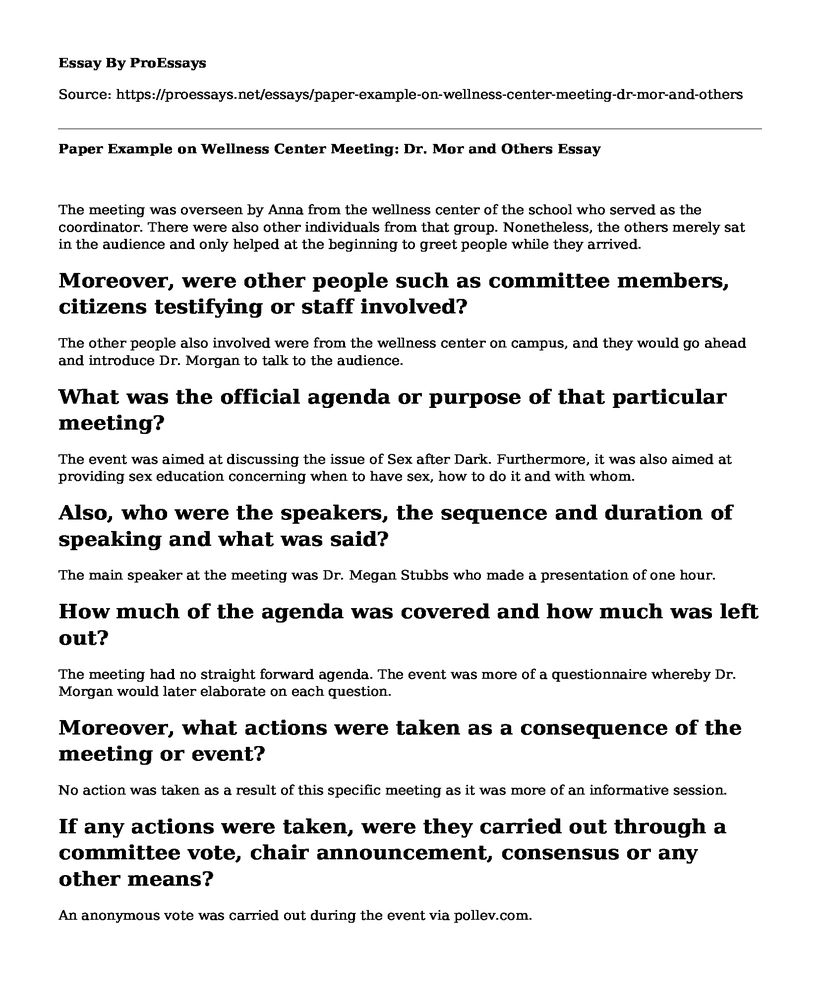The meeting was overseen by Anna from the wellness center of the school who served as the coordinator. There were also other individuals from that group. Nonetheless, the others merely sat in the audience and only helped at the beginning to greet people while they arrived.
Moreover, were other people such as committee members, citizens testifying or staff involved?
The other people also involved were from the wellness center on campus, and they would go ahead and introduce Dr. Morgan to talk to the audience.
What was the official agenda or purpose of that particular meeting?
The event was aimed at discussing the issue of Sex after Dark. Furthermore, it was also aimed at providing sex education concerning when to have sex, how to do it and with whom.
Also, who were the speakers, the sequence and duration of speaking and what was said?
The main speaker at the meeting was Dr. Megan Stubbs who made a presentation of one hour.
How much of the agenda was covered and how much was left out?
The meeting had no straight forward agenda. The event was more of a questionnaire whereby Dr. Morgan would later elaborate on each question.
Moreover, what actions were taken as a consequence of the meeting or event?
No action was taken as a result of this specific meeting as it was more of an informative session.
If any actions were taken, were they carried out through a committee vote, chair announcement, consensus or any other means?
An anonymous vote was carried out during the event via pollev.com.
Furthermore, how were people dressed and was it possible to identify different types of "players" based on the dress code?
Individuals in attendance were dressed casually in clothing suited for the summer. Moreover, it was easy to identify the different types of "players" present whereby a significant number were students who dressed in a comfortable and normal way.
Also, were there any differences marked off between the participants and the audience and if so, were they made evident through seating arrangements, microphones or any other means?
During the event, the difference between the participants and the audience was well marked off. In the conference room, there were a lot of chairs like in an auditorium. The room was meant for only about 15 audience members, but there were chairs set up for about 50 people. There was a podium set at the front of the room with a big projection screen where Dr. Megan was standing and talking while showing a slide show with questions being asked.
Did the various participants talk in a casual, formal, technical, colloquial or any other way and who among them spoke as an "expert" or "community representative"?
In the course of the meeting, the participants in attendance were talking very casually as if they were merely having a conversation.
Moreover, did people try to persuade each other through recitation of facts, telling stories, invoking rules and laws or any other way and did they sound angry, powerful or humble?
Contact between different people at the meeting was initiated by Dr. Megan who got people to interact by asking questions and having the audience respond. Furthermore, Dr. Megan made jokes which made the meeting funny and exciting.
Also who were not speaking during the event?
There were a lot of people who were shy and wouldn't talk, but all performers who accompanied Dr. Megan spoke to the audience.
Therefore, in the course of the meeting, were there observations of people engaging from a critical action stance or a missionary mindset and if so, how were they perceived by others?
During the meeting, there was no judgment as everyone was respectful.
Furthermore, in what ways did factors of class, race, gender, sex, socioeconomic status, and other diversity issues affect who was not heard, who was heard, and how they were heard in addition to weather some voices were embraced more than others and why?
During the meeting, the factors did not influence who was heard or who was not as everyone had the chance to talk. However, I feel like some people were more embarrassed by the topic; thus why they kept quiet. Furthermore, in attendance, there was a variety of different class, race, and gender.
What "institutions" or groups did you represent, why did you identify with a specific position being put forward if any and what was the balance between agreement due content of the argument vs. agreement because of affiliation with the speaker?
My attendance represented men who were curious about sex toys. I further identified with the position that sex toys are not for men as I have never used any. However, I agreed mainly due to the content of the argument rather than affiliation with the speaker.
Moreover, was there an encounter with any personal myths, stereotypes or biases and what past belief or opinions were challenged by other participants?
I uncovered the myth that sex toys are strictly for lonely people. Moreover, the meeting challenged my belief that sex toys are only meant for women.
In conclusion, did this experience change you in any way?
I was changed by this experience as I am now open to using sex toys as a means of achieving sexual pleasure.
Reference
Stubbs, M. (2018). Sexologist Megan. Retrieved from www.sexologistmegan.com/
Cite this page
Paper Example on Wellness Center Meeting: Dr. Mor and Others. (2022, Dec 29). Retrieved from https://proessays.net/essays/paper-example-on-wellness-center-meeting-dr-mor-and-others
If you are the original author of this essay and no longer wish to have it published on the ProEssays website, please click below to request its removal:
- Assignment Example on Black Death Epidemic
- Impacts of Collective Bargaining Agreement to the Public Essay
- Ebola in the United States - Paper Example
- Diabetes Mellitus Type 1 Research Paper Example
- Essay Sample on Sex Culture
- Essay Sample on Home Health Care & Hospice: A Growing Need for Elderly Care
- Breastfeeding, Parenting, and Academic Performance: Analyzing the Impact







